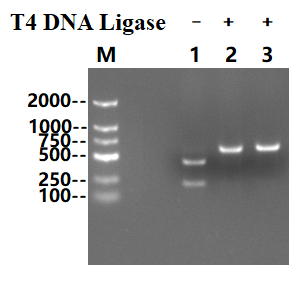57 kD
10 mM Tris-HCl、50 mM KCl、1 mM DTT、0.1 mM EDTA、50% Glycerol (pH 7.4 @ 25°C)
Store at -25 ~ -15℃ for 1 years
[1] Williamson A, Pedersen H. Recombinant expression and purification of an ATP-dependent DNA ligase from Aliivibrio salmonicida. Protein Expr Purif. 2014 May; 97:29-36.
[2] Liu X, Huang A, Luo D, Liu H, Han H, Xu Y, Liang P. Use of adenylate kinase as a solubility tag for high level expression of T4 DNA ligase in Escherichia coli. Protein Expr Purif. 2015 May;109:79-84. Epub 2015 Feb 17.
T4 DNA ligase is a type of DNA ligase. DNA ligase catalyzes the formation of phosphodiester bonds at single-stranded DNA breaks in double-stranded DNA in vivo. DNA ligase has important biological functions in organisms. In DNA repair and recombination, DNA ligase plays a role in connecting gaps. In the process of DNA replication, the synthesis of the lagging strand is discontinuous, and DNA ligase connects the discontinuous DNA strand into a continuous DNA strand. It does not contain DNA endonuclease, exonuclease and phosphatase, and does not contain RNA enzyme.
Storage Solution: 400U/μl T4 DNA Ligase、10 mM Tris-HCl、50 mM KCl、1 mM DTT、0.1 mM EDTA、50% Glycerol (pH 7.4 @ 25°C) 10*Reaction Buffer: 500 mM Tris-HCl、100 mM MgCl2、10 mM ATP、100 mM DTT (pH 7.5 @ 25°C)
1、Set up the following reaction in a microcentrifuge tube on ice. Add the following components in sequence. Note that the table shows a ligation using1. a molar ratio of 1:5 vector to insert for the indicated DNA sizes.
Components | Volume 20μl |
10* T4 DNA Ligase Buffer | 2 μl |
Vector DNA (such as pET-28a 5369bp) | 50ng |
Insert DNA (530bp) | 25ng |
Nuclease-free water | Up to 20 μL |
T4 DNA Ligase | 1μl |
2. Gently mix the reaction through the up and down pipette, and inhale the liquid briefly.
3. For sticky ends, incubate at 16°C overnight or at room temperature for 10 minutes.
4. For blunt ends or single base overhangs, incubate overnight at 16°C or room temperature for 2 hours (alternatively, high concentrations of T4DNA ligase can be used for 10 minutes of ligations).
5. Chill on ice and transform 1-5 μl of the reaction into competent cells.
1. ATP is an essential cofactor in the reaction. This is in contrast to E. coli DNA Ligase, which requires NAD as a cofactor.
2. If T4 DNA Ligase is to be diluted, it is recommended that it be diluted with 50% glycerol in storage buffer and stored at -20°C. 3. Room temperature ligation

The two DNA strands after enzymatic digestion and purification were used as substrate for enzyme linkage and incubated at 25℃ for 2 hours. The reaction was analyzed by 1% agarose gel electrophoresis.
M: DNA marker
Lane 1 negative control
Lane 2 and 3 Experimental result
2μg (R: reducing condition, N: non-reducing condition).